Germany map
Where is Germany. What is Germany
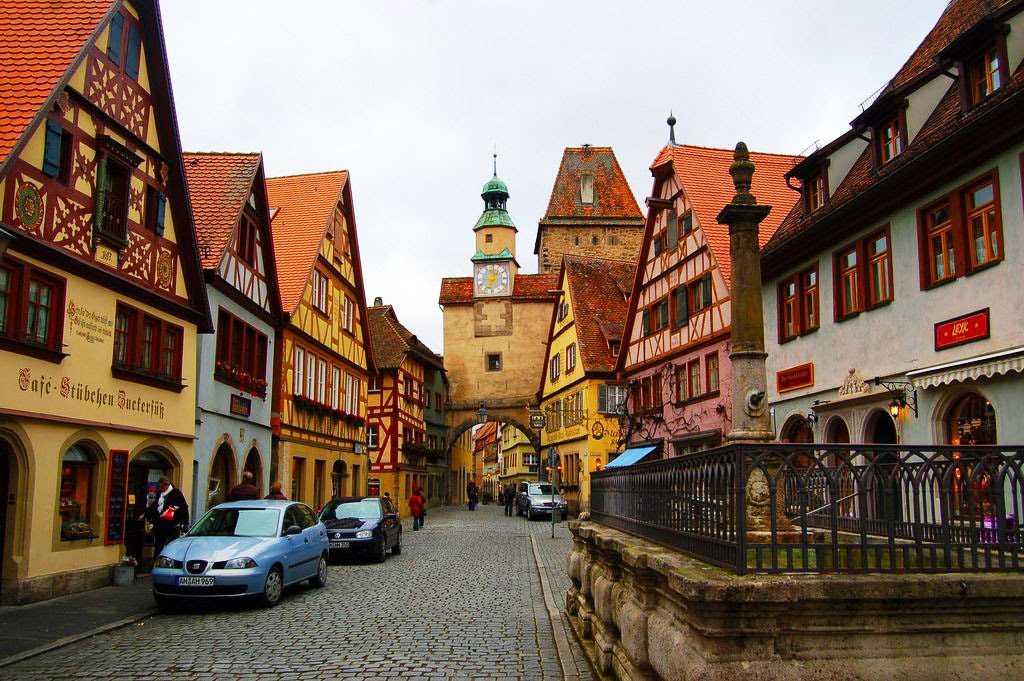 https://holidaygid.ru
https://holidaygid.ru
The Federal Republic of Germany (Bundesrepublik Deutschland) is a model European secular federal State with an advanced and leading economy. The country is located in the center of Western Europe and has all the advantages of this placing. It is surrounded on all sides by the countries of the European Union: France, Austria, Switzerland, Luxembourg, Denmark, Belgium, the Netherlands, the Czech Republic and Poland.
This country sets the pace of life and rules for the entire European Union, having a leading position in it. At the same time, Germany is a country with great tourist opportunities and can offer its guests many attractions to see.
The country's territory occupies 357 th km2 with a population of about 83 M people. Accordingly, the population density is 232 people / sq. km. The volume of the country's GDP is a fourth rank in the world, as well as the human development index (HDI). The time zone is the same throughout the territory and is UTC +1 in winter and UTC +2 in summer. Right-hand traffic. Studded tires are prohibited for any cars.
Basic weather information in Germany: most of the country is in the temperate continental climate. The northern part of the country is generally warmer, but more windy and rainy, while the south is colder due to the mountainous landscape. The average daily temperature is 22-24 degrees in summer and 0 degrees in winter.
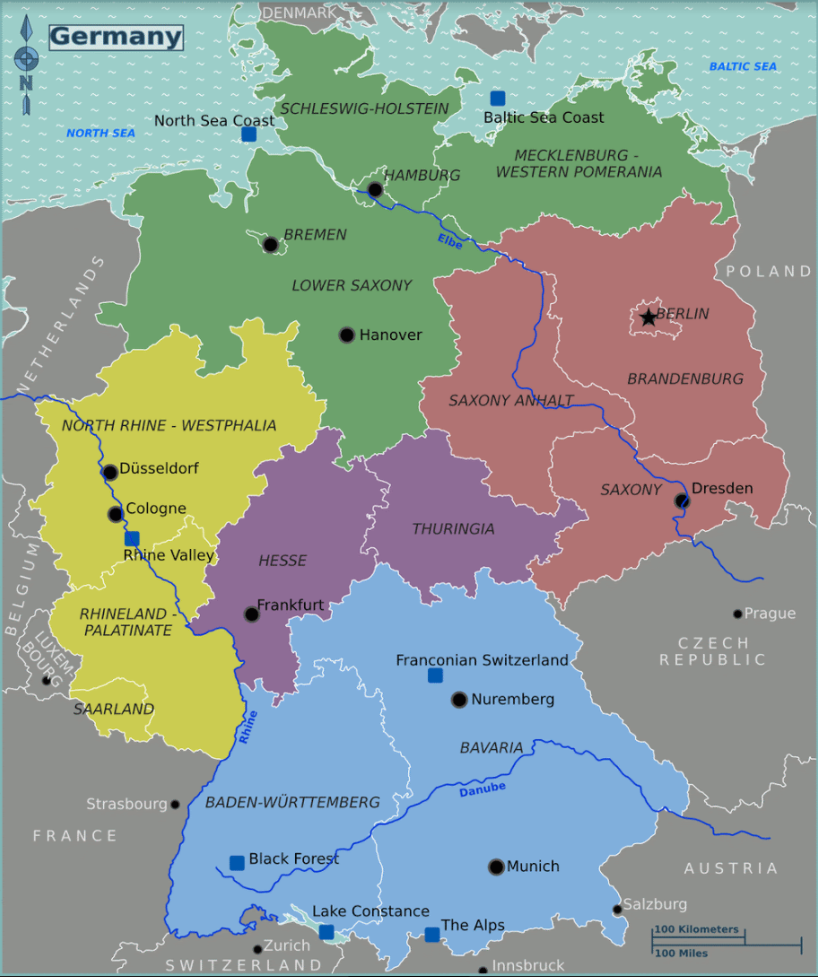 https://www.mapsland.com/
https://www.mapsland.com/
Germany regions
Germany is regionally divided into 16 equal autonomous lands, each of them:
- has its own capital,
- democratically elected government,
- own constitution,
- limited international sovereignty,
- has the right to pass laws in certain areas.
German Lands and their capitals:
Baden-Württemberg
The region is located in southwestern Germany with its capital in Stuttgart, formed on April 25, 1952. Land with a developed economy and one of the lowest unemployment rates in the country, with an area of 36 thou km² and a population of about 11 m people.
Free State of Bavaria (Freistaat Bayern)
It is located in the south and southeast of Germany with its capital in Munich (München). Bavaria has the largest area in Germany, 71 thou km², and a population of about 13 M.
Berlin
The capital and largest city of Germany. It is part of Germany as one of 16 lands with an area of 891.7 km² and a population of about 3.6 m people. Located in the center of Brandenburg, but not part of it.
Brandenburg
Land of the Federal Republic of Germany with the capital in the city of Potsdam (Potsdam), an area of 30 thou km², and a population of about 2.5 m people. Located in the east of the North German Plain.
Free Hanseatic City of Bremen (Freie Hansestadt Bremen)
The smallest region (City-state) within Germany. It consists of two West German cities, Bremerhaven and Bremen (separated by the territory of Lower Saxony), with the capital in Bremen, an area of 419 km² and a population of about 0.6 m people.
Free and Hanseatic City of Hamburg (Freie und Hansestadt Hamburg).
North German city-state, the second largest city within Germany with an area of 755 km² and a population of 1.8 M.
Hessen
Land in the center of Germany with the capital in Wiesbaden, an area of 21 thou km² and a population of about 6 m people.Hessen is very economically developed region with largest city Frankfurt in its composition.
Mecklenburg-Vorpommern
The German state with the lowest population density, the capital in Schwerin, with an area of 23 thou km² and a population of 1.6 M. It is located in northeastern Germany and has access to the Baltic Sea.
Lower Saxony (Niedersachsen)
It is the second largest area in Germany after Bavaria. The capital is the city of Hannover, the area of the region is 48 thou km², the population is about 8 M people. Has access to the North Sea.
North Rhine-Westphalia (Nordrhein-Westfalen)
It is located in the west of Germany, has an area of 34 thou km², most populous Land (18 M) and most urbanised with 29 big german cities (from 80). The capital is Düsseldorf.
Rheinland-Pfalz
The land is located in the west of Germany, with the capital in Mainz, a population of 4 M and an area of 20 thou km². This territory is very interesting historically and touristically.
Saarland
The capital of the state is Saarbrücken. The population is about 1M people, the area is 2 568 km². It shares borders with Luxembourg and France. In the past the region was one of the centers of coal mining. But now is not economically developed.
Free State of Saxony (Freistaat Sachsen)
Located in the east of Germany, with the capital in Dresden (Dresden), an area of 18,4 thou km² and a population of 4 M people. Traditionally strong in education.
Saxony-Anhalt (Sachsen-Anhalt)
One of the new lands in Germany. Formed in 1947, with its capital in Magdeburg, an area of 20,5 th km² and a population of 2.2 M people. The region is in relative economic depression.
Schleswig-Holstein
Located in the north of the country, besides the German lands, it has common borders with Denmark. The capital is Kiel, the land area is 15,8 th km², inhabited by 2.8 M people. The main sectors of the economy are logistics (sea and road transport), agriculture, sea fishing.
Free State of Thuringia (Freistaat Thüringen)
The capital in the city of Erfurt. Located in the eastern part of the country. The area of the region is 16 th km²? population is 2.1 M. This german region is famous for its forests, mountain peaks and medieval settlements and a great role in the history of the Protesten movement (Luther's activities in Erfurt Cathedral).
The most interesting sights of Germany
Cologne Cathedral (Kölner Dom)
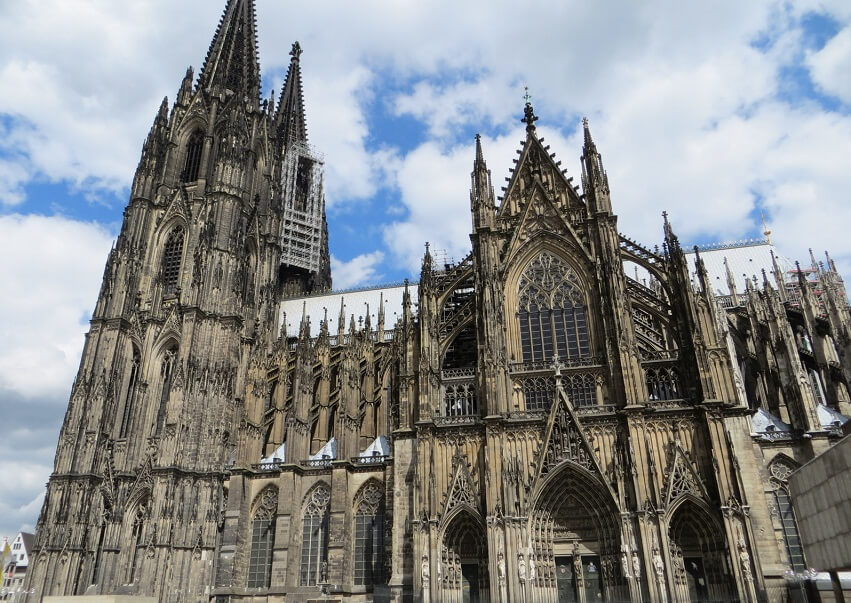 www.theplacement.ru/travel-directory/kelnskij-sobor
www.theplacement.ru/travel-directory/kelnskij-sobor
Catholic Gothic cathedral, founded in 1248. Listed as a World Cultural Heritage, it ranks third in the list of the tallest churches in the world. It is a very stately building with two identical spiers, a massive dark façade and stunning views on the Rhine. It is very popular with the tourists.
Address: Domkloster 4, 50667 Köln, Germany.
Neuschwanstein Castle (Schloss Neuschwanstein)
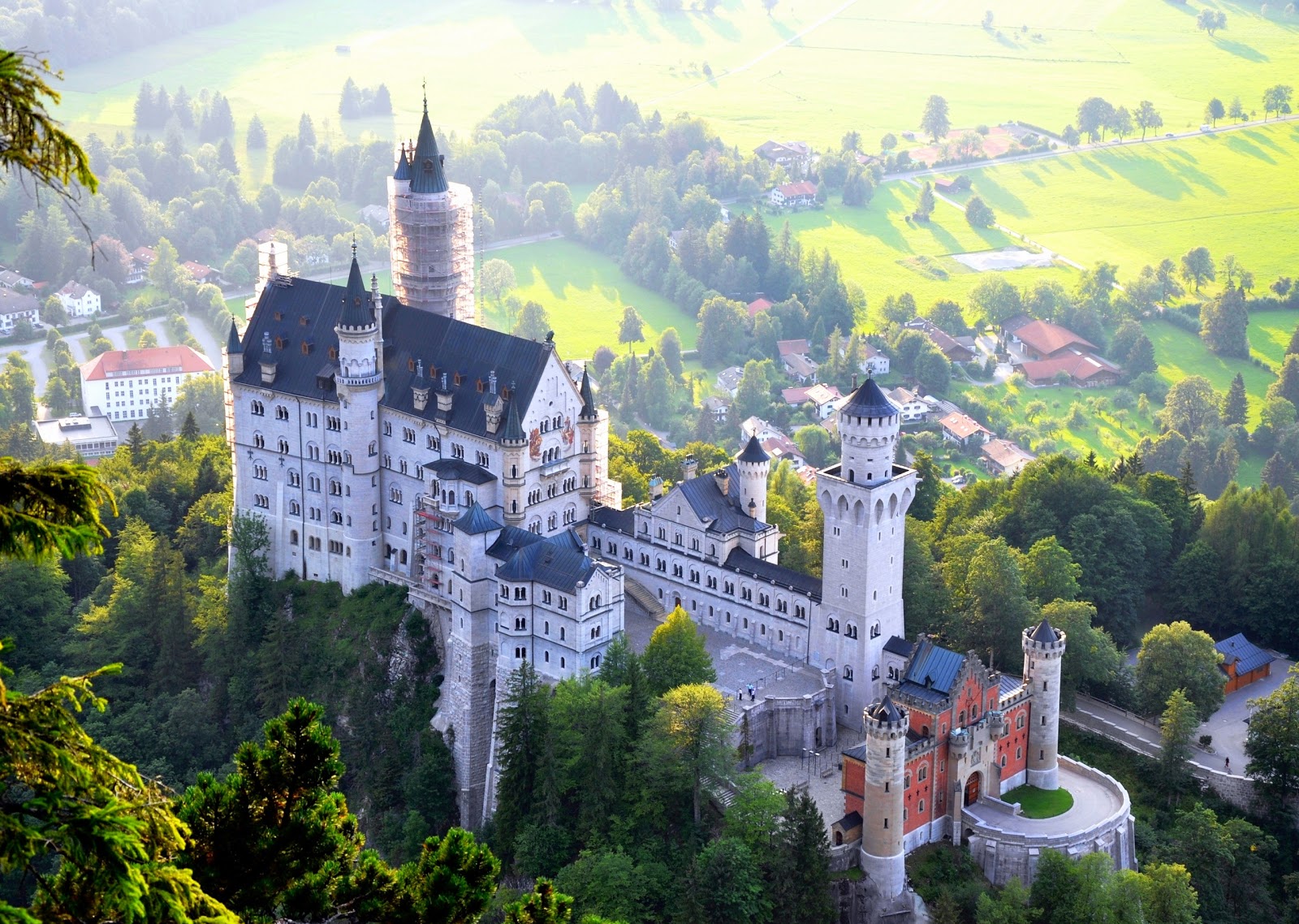 https://wallhere.com/
https://wallhere.com/
Translated from German as "New Swan Stone". The most beautiful castle in Bavaria. Built by King Ludwig II in 1869, it is now one of the most popular tourist destination in southern Germany. The attraction is visited by about 1.3 million visitors annually.
Address: Neuschwansteinstraße 20, 87645 Schwangau, Germany
The Monument to the Battle of the Nations (Völkerschlachtdenkmal)
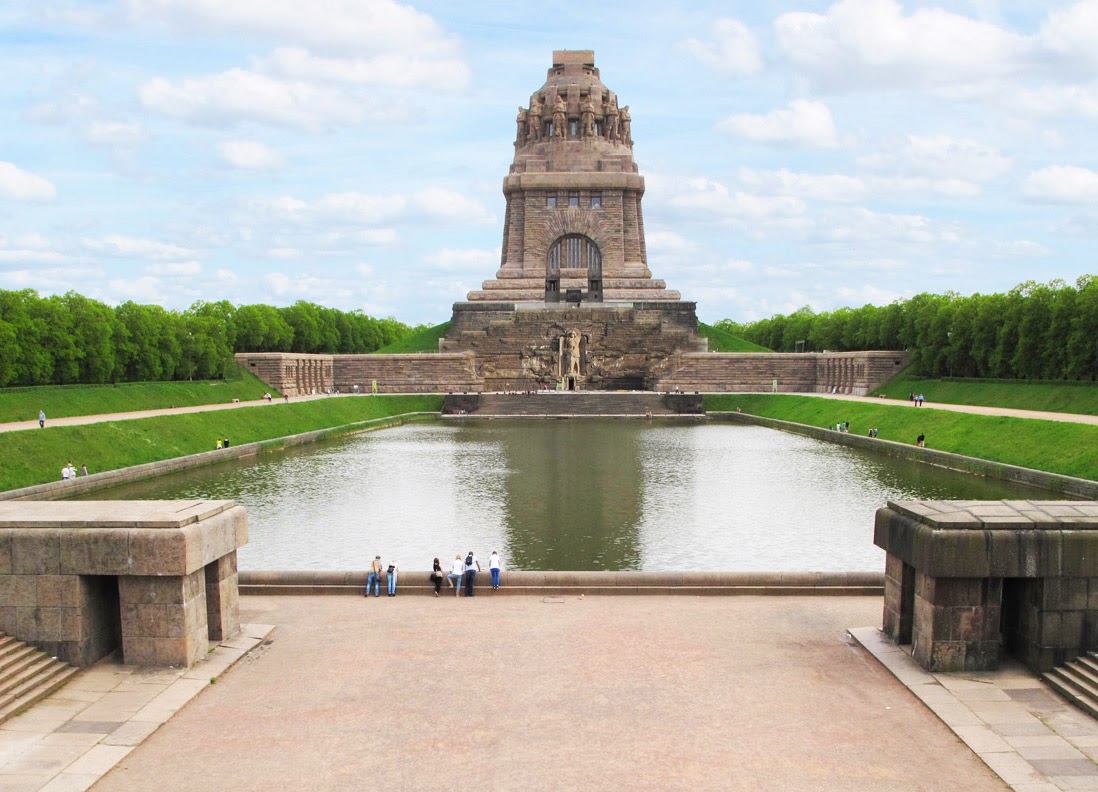 https://www.bundesrasenschau.info/
https://www.bundesrasenschau.info/
A branch of the Leipzig History Museum, one of its main attractions. The physically largest monument in Europe. Erected in memory of the victory in 1813 of a coalition of Austrian, Prussian, Russian and Swedish troops over the Army of Napoleon Bonaparte. Before the First World War, the Battle of Leipzig was considered as the most massive and blooody in European history.
Location: Str. des 18. Oktober 100, 04299 Leipzig, Germany
Buchenwald concentration camp
https://upload.wikimedia.org/
National Memorial Complex, opened instead of the place of a concentration camp, which functioned from 1937 to 1950 (of which in 1945-1950 in the Russian NKVD system). In total, about 250 th people from all European countries passed through the camp, of which at least 56 th died. In 1951, a memorial plaque was installed, and in 1958, a national memorial complex was opened.
Location: 99427 Weimar, Germany.
Dresden State Art Collections (Staatliche Kunstsammlungen Dresden)
https://www.zdf.de/
A collection of approximately 750 paintings by old masters, acquired by Saxon rulers in the 18th century. Top quality fine art. Raphael's Sextine Madonna, masterpieces by Rembrandt, Titian and many other masters.
Location: Theaterplatz 1, 01067 Dresden, Germany.
Eltz Castle (Burg Eltz)
https://wallpapers-all.com
Medieval baroque building, presumably built in the 12th century. It is noteworthy that it was never captured and defeated. The castle has a collection of medieval weapons, a treasury, and many original medieval household items.
Location: 56294 Wierschem, Germany
Maria Laach Abbey (Benediktinerabtei Maria Laach)
https://otvet.mail.ru/question/188069564
Medieval monastery, founded in 1093. One of the best conserved and most remarkable buildings in Germany, made in the Romanesque style. In addition to the monastery itself, you can visit Lake Laakh (fishing, camping, boat rental). As well you can live in lakeside hotel, to do some craft job in workshops with training opportunities.
Location: 56653 Glees, Germany
Palatine Chapel, Aachen (Pfalzkapelle)
https://bestlj.ru/
A unique temple (chapel), an architectural monument of the time of Charlemagne built in 805. It is the only preserved intact building of the Aachen Palace complex. In the chapel of the temple, the coronation ceremony of the emperors of the Holy Roman Empire took place for 600 years. Charlemagne himself was buried in this chapel in 814.
Location: Domhof 1, 52062 Aachen, Germany
Lichtenstein Castle (Schloss Lichtenstein)
https://wallpaperscraft.ru
"Fairy-tale" castle in the neo-gothic style in Baden-Württemberg. It is interesting because it was built in 1840-1842 on the foundations of a previously destroyed castle of about 1200 year in accordance with ideas about a medieval fortress, popular in the 19thcentury. The building houses has a very large collection of historical weapons and armor.
Location: Schloß Lichtenstein 1, 72805 Lichtenstein, Germany
The Alte Pinakothek
https://f.otzyv.ru/
Part of the Munich Art Gallery, one of the most famous galleries in the world. Here are the works of masters of the Middle Ages, about 700 canvases, painted in the XIV-XVIII centuries. A distinctive feature of this collection is a deliberate extreme asceticism of decoration of the halls; the exhibits of the museum are only paintings.
Location: Barer Str. 27, 80333 München, Germany.
Germany largest airports' list
https://www.dw.com/
Germany, located in the center of western Europe, has an excellent system of ground and air transportation. It is not a problem in getting to the country from anywhere in Europe and even the world, as well as traveling around the Germany. It is possible to fly in Germany on a very budgetary basis: about 30 - 35% of all flights are made by low-cost airlines (discounters).
List of the largest international airports in Germany:
|
Rhein-Main The largest airport in Germany, accepts many international and transit flights. Capacity of 65,000 people, passenger traffic of about 58 million people. |
Fraport AG, Frankfurt Airport Services Worldwide, 60547 Frankfurt am Main |
|
Flughafen München «Franz Josef Strauß» It is in second place in Germany in terms of passenger traffic. Capacity of 50,000 people, passenger traffic is |
Nordallee 25, 85356 München-Flughafen, Germany |
|
Flughafen Berlin Brandenburg (BER) New airport in the vicinity of berlin. Capacity of 48,000 people. |
Melli-Beese-Ring 1, 12529 Schönefeld, Germany |
|
Flughafen Düsseldorf Just 8 km from the city. Capacity 22,000 people; passenger traffic 21 million. |
Flughafenstraße 105, 40474 Düsseldorf, Germany |
|
Flughafen Hamburg The city center is 9 km away. Capacity of 16,000 people; passenger traffic of about 13 million people (2013) |
Flughafenstr. 1-3, 22335 Hamburg, Germany |
|
Köln/ Bonn Airport Located 16 km from Bonn, 15 km from Cologne. Capacity of 14,000 people; passenger traffic 9 million (2013) |
Kennedystraße, 51147 Köln, Germany |
|
Flughafen Stuttgart Capacity of 14,000 people, passenger traffic of about 9 million people / year |
Flughafenstraße 32, 70629 Stuttgart, Germany |
Germany high speed train map
Germany has the largest rail network in Central Europe, carrying two billion passengers annually. The length of railway lines is over 33 th km. High-speed traffic between cities is carried out by the Intercity-Express (ICE) network, which provides a speed of 160 - 330 km / h. The high-speed train traffic map is as follows:
upload.wikimedia.org
The five largest train stations in Germany
|
Berlin Hauptbahnhof The largest train station in Berlin, taking long-distance trains, commuter trains and the metro. 300 thousand passengers daily. |
Hauptbahnhof, Europaplatz 1, 10557 Berlin, Germany |
|
München Hauptbahnhof Munich main station, short and long-distance trains. the largest railway station in germany by the number of tracks. passenger traffic is 350,000 passengers per day, the total area of the station is 760,000 m2. |
Bayerstraße 10A, 80335 München, Germany |
|
Frankfurt Hauptbahnhof 25 platforms, 450 thousand passengers daily |
Am Hauptbahnhof, 60329 |
|
Köln Hauptbahnhof 280 thousand passengers daily, 11 railway tracks, 5 platforms. |
Trankgasse 11, 50667 Köln, Germany |
|
Hamburg Hauptbahnhof Hamburg Central Station, through which all branches of the metro and commuter trains pass. |
20099 Hamburg, Germany |
Highways of Germany
https://autotraveler.ru/germany/
Germany's autobahns are the 4th longest national road network in the world, after China, USA and Spain; it is about 13 th km. The German autobahns are famous all over the world among lovers of fast driving because they have practically no speed limits. They are designated by the letter "A" and the number. The longest autobahn in Germany - the A7, has a length of 962 kilometers and leads from Austria to Denmark.
Editor's Choice: romantic road germany map
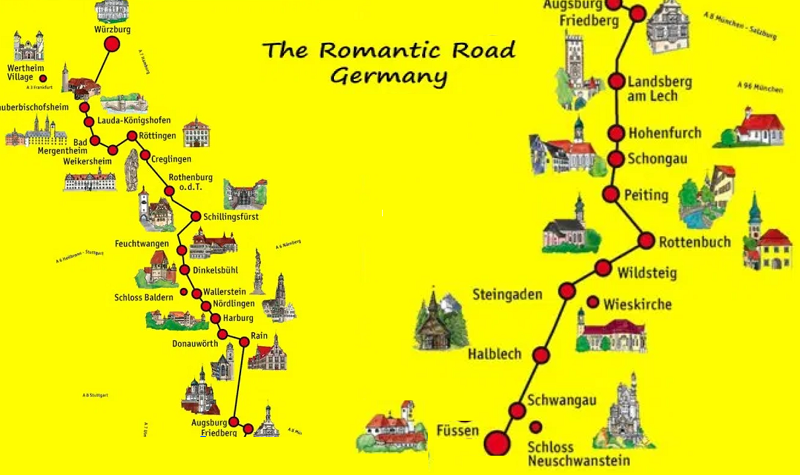
One of the most popular tourist route: germany romantic road is a 360-kilometer scenic route connecting 28 attractions of Bavaria and Baden-Württemberg. It is recommended to take this route from north to south, starting from Wurzburg. Then the Bavarian Alps, one of the most beautiful regions in Europe, will remain “for dessert”. The route connects the historic cities of Würzburg and Augsburg, the three medieval fortified cities Rothenburg ob der Tauber, Dinkelsbühl and Nördlingen, and ends with the most popular among tourists Neuschwanstein Castle and the Alps. The route can be traversed using public transport, car, bicycle or on foot. When traveling by bike or on foot, it is better to start the route in the south: it is easier to go down from the foothills of the Alps than up.
|
Towns from North to South |
Distances between towns |
|
Würzburg |
|
|
Tauberbischofsheim |
23.5 miles (38 km) |
|
Lauda-Königshofen |
6 miles (10km) |
|
Bad Mergentheim |
7 miles (11km) |
|
Creglingen |
15.5 miles (25 km) |
|
Rothenburg ob der Tauber |
12 miles (19 km) |
|
Dinkelsbühl |
28 miles (45 km) |
|
Nördlingen |
20 miles (32 km) |
|
Harburg |
10.5 miles (17 km) |
|
Donauwörth |
7.5 miles (12 km) |
|
Augsburg |
27 miles (44 km) |
|
Landsberg am Lech |
24 miles (39 km) |
|
Schongau |
18 miles (29 km) |
|
Pfaffenwinkel (Rottenbuch) |
10.5 miles (17 km) |
|
Schwangau |
18 miles (29 km) |
|
Füssen |
2.5 miles (4 km) |